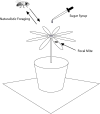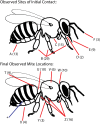Varroa destructor Mites Can Nimbly Climb from Flowers onto Foraging Honey Bees
- PMID: 27942015
- PMCID: PMC5152851
- DOI: 10.1371/journal.pone.0167798
Varroa destructor Mites Can Nimbly Climb from Flowers onto Foraging Honey Bees
Abstract
Varroa destructor, the introduced parasite of European honey bees associated with massive colony deaths, spreads readily through populations of honey bee colonies, both managed colonies living crowded together in apiaries and wild colonies living widely dispersed in natural settings. Mites are hypothesized to spread between most managed colonies via phoretically riding forager bees when they engage in robbing colonies or they drift between hives. However, widely spaced wild colonies show Varroa infestation despite limited opportunities for robbing and little or no drifting of bees between colonies. Both wild and managed colonies may also exchange mites via another mechanism that has received remarkably little attention or study: floral transmission. The present study tested the ability of mites to infest foragers at feeders or flowers. We show that Varroa destructor mites are highly capable of phoretically infesting foraging honey bees, detail the mechanisms and maneuvers by which they do so, and describe mite behaviors post-infestation.
Conflict of interest statement
The authors have declared that no competing interests exist.
Figures



Similar articles
-
Are Dispersal Mechanisms Changing the Host-Parasite Relationship and Increasing the Virulence of Varroa destructor (Mesostigmata: Varroidae) in Managed Honey Bee (Hymenoptera: Apidae) Colonies?Environ Entomol. 2017 Aug 1;46(4):737-746. doi: 10.1093/ee/nvx077. Environ Entomol. 2017. PMID: 28486589
-
Mite bombs or robber lures? The roles of drifting and robbing in Varroa destructor transmission from collapsing honey bee colonies to their neighbors.PLoS One. 2019 Jun 21;14(6):e0218392. doi: 10.1371/journal.pone.0218392. eCollection 2019. PLoS One. 2019. PMID: 31226130 Free PMC article.
-
Population growth of Varroa destructor (Acari: Varroidae) in honey bee colonies is affected by the number of foragers with mites.Exp Appl Acarol. 2016 May;69(1):21-34. doi: 10.1007/s10493-016-0022-9. Epub 2016 Feb 24. Exp Appl Acarol. 2016. PMID: 26910522 Free PMC article.
-
Biology and control of Varroa destructor.J Invertebr Pathol. 2010 Jan;103 Suppl 1:S96-119. doi: 10.1016/j.jip.2009.07.016. Epub 2009 Nov 11. J Invertebr Pathol. 2010. PMID: 19909970 Review.
-
Varroa destructor: how does it harm Apis mellifera honey bees and what can be done about it?Emerg Top Life Sci. 2020 Jul 2;4(1):45-57. doi: 10.1042/ETLS20190125. Emerg Top Life Sci. 2020. PMID: 32537655 Free PMC article. Review.
Cited by
-
A gene drive does not spread easily in populations of the honey bee parasite Varroa destructor.Apidologie. 2021;52(6):1112-1127. doi: 10.1007/s13592-021-00891-5. Epub 2021 Oct 15. Apidologie. 2021. PMID: 35068598 Free PMC article.
-
Raised seasonal temperatures reinforce autumn Varroa destructor infestation in honey bee colonies.Sci Rep. 2021 Nov 15;11(1):22256. doi: 10.1038/s41598-021-01369-1. Sci Rep. 2021. PMID: 34782664 Free PMC article.
-
Floral traits affecting the transmission of beneficial and pathogenic pollinator-associated microbes.Curr Opin Insect Sci. 2021 Apr;44:1-7. doi: 10.1016/j.cois.2020.08.006. Epub 2020 Aug 28. Curr Opin Insect Sci. 2021. PMID: 32866657 Free PMC article. Review.
-
Factors Associated with Honey Bee Colony Losses: A Mini-Review.Vet Sci. 2020 Oct 30;7(4):166. doi: 10.3390/vetsci7040166. Vet Sci. 2020. PMID: 33143134 Free PMC article. Review.
-
Effects of sugar feeding supplemented with three plant extracts on some parameters of honey bee colonies.Saudi J Biol Sci. 2021 Apr;28(4):2076-2082. doi: 10.1016/j.sjbs.2021.02.050. Epub 2021 Feb 20. Saudi J Biol Sci. 2021. PMID: 33911923 Free PMC article.
References
-
- Anderson DL, Trueman JWH. Varroa jacobsoni (Acari: Varroidae) is more than one species. Exp Appl Acarol 2000;24:165–189. - PubMed
-
- Kevan PG, Hannan MA, Ostiguy N, Guzman-Novoa E. A summary of the Varroa-virus disease complex in honey bees. Am Bee J. 2006;146:694–697.
-
- Korpela S, Aarhus A, Fries I, Hansen H. Varroa jacobsoni Oud. in cold climates: population growth, winter mortality and influence on the survival of honey bee colonies. J Apic Res. 1992;31:157–164.
-
- Fries I, Imdorf A, Rosenkranz P. Survival of mite infested (Varroa destructor) honey bee (Apis mellifera) colonies in a Nordic climate. Apidologie. 2006;37:564–570.
MeSH terms
LinkOut - more resources
Full Text Sources
Other Literature Sources

